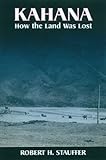Kahana : How the Land Was Lost / Robert H. Stauffer.
Material type: TextPublisher: Honolulu : University of Hawaii Press, [2003]Copyright date: ©2003Description: 1 online resource (288 p.)Content type:
TextPublisher: Honolulu : University of Hawaii Press, [2003]Copyright date: ©2003Description: 1 online resource (288 p.)Content type: - 9780824825904
- 9780824846626
- 333.3/19693/09034 21
- HD1333.U62
- online - DeGruyter
- Issued also in print.
| Item type | Current library | Call number | URL | Status | Notes | Barcode | |
|---|---|---|---|---|---|---|---|
 eBook
eBook
|
Biblioteca "Angelicum" Pont. Univ. S.Tommaso d'Aquino Nuvola online | online - DeGruyter (Browse shelf(Opens below)) | Online access | Not for loan (Accesso limitato) | Accesso per gli utenti autorizzati / Access for authorized users | (dgr)9780824846626 |
Frontmatter -- Contents -- Acknowledgments -- A Note on Transliteration and Language -- Maps -- Introduction. How the Land Was Taken, How the Land Was Lost -- Chapter 1. The History of the Land, 1846-1855 -- Chapter 2. A Second Generation, 1856-1873 -- Chapter 3. Counter-Revolution, 1874-1887 -- Chapter 4. The Land Is Lost, 1888-1903 -- Chapter 5. Denouement, 1904-1920 -- Epilogue -- Appendix 1. Related information from Stauffer doctoral dissertation -- Appendix 2. The maka'āinana families, 1856-1873 -- Appendix 3. Maka'āinana relations, 1874-1887 -- Appendix 4. Various competing claims for several of the kuleana from the 1888-1903 period -- Notes -- Glossary -- Selected Bibliography -- Index -- About the Author
restricted access online access with authorization star
http://purl.org/coar/access_right/c_16ec
This volume is the most detailed case study of land tenure in Hawaii. Focusing on kuleana (homestead land) in Kahana, Oahu, from 1846 to 1920, the author challenges commonly held views concerning the Great Mähele (Division) of 1846-1855 and its aftermath. There can be no argument that in the fifty years prior to the 1893 overthrow of the Hawaiian monarchy, ninety percent of all land in the Islands passed into the control or ownership of non-Hawaiians. This land grab is often thought to have begun with the Great Mähele and to have been quickly accomplished because of Hawaiians' ignorance of Western law and the sharp practices of Haole (white) capitalists. What the Great Mähele did create were separate land titles for two types of land (kuleana and ahupuaa) that were traditionally thought of as indivisible and interconnected, thus undermining an entire social system. With the introduction of land titles and ownership, Hawaiian land could now be bought, sold, mortgaged, and foreclosed. Using land-tenure documents recently made available in the Hawaii State Archives' Foster Collection, the author presents the most complete picture of land transfer to date. The Kahana database reveals that after the 1846 division, large-scale losses did not occur until a hitherto forgotten mortgage and foreclosure law was passed in 1874. Hawaiians fought to keep their land and livelihoods, using legal and other, more innovative, means, including the creation of hui shares. Contrary to popular belief, many of the investors and speculators who benefited from the sale of absentee-owned lands awarded to alii (rulers) were not Haole but Päkë (Chinese). Kahana: How the Land Was Lost explains how Hawaiians of a century ago were divested of their land--and how the past continues to shape the Island's present as Hawaiians today debate the structure of land-claim settlements.
Issued also in print.
Mode of access: Internet via World Wide Web.
In English.
Description based on online resource; title from PDF title page (publisher's Web site, viewed 02. Mrz 2022)


